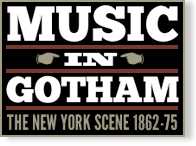Philharmonic Society of New York Concert: 2nd
Event Information
Venue(s):
Academy of Music
Conductor(s):
Carl Bergmann
Event Type:
Orchestral
Record Information
Status:
Published
Last Updated:
7 November 2023
Performance Date(s) and Time(s)
06 Jan 1872, 8:00 PMPerformers and/or Works Performed
Citations
“The second Philharmonic concert of the present season occurred at the Academy of Music last evening. As usual, the house was filled, and a great deal of applause was bestowed upon the interpretation of the programme, if not upon the programme itself. The selections recited were as follows [see above].
The familiar charge of lack of variety can again be urged against this bill. Both Reinecke and Raff are representative musicians of kindred aspirations, and the brief excerpt from Weber’s compositions, and the vivacious but thin music of Haydn scarcely offset the heavy symphony and the concerto. The latter was the most effective piece of the evening, thanks mainly to the admirable playing of Mr. S. G. Mills on a magnificent Steinway. If the second and third movements of the work had been equal in respect of treatment to the first, the title of concerto would have been better deserved. In the allegro are called into requisition, and in the right proportions, the piano and the band. But the adagio is rather a solo with a violin obligato than anything else, and the allegro con brio is so devoid of ideas as to be inferior to either of the previous parts. We have already said that Mr. Mills’ performance was admirable, and a knowledge of the difficulties of the piece, which an audience is not expected to possess, will make the gentleman’s mastery of his task still more praiseworthy in the eyes of the student. In point of appreciation and expression, for crisp definition of every note in the most rapid passages and for alternate nicety of delivery and breadth and vigor of phrasing, we cannot hope that Mr. Mills’ efforts will ever be excelled. Had a solo violinist been intrusted with a share of the second movement, the results would have been more satisfying. Mr. Matzka is an accomplished and industrious musician, but the tone of an habitual soloist cannot be expected of an artist who is never missed from the orchestra. In Raff’s symphony, as in the concerto, the first movement, illustrative of impressions at dawn in the forest, is the most felicitous, in matter and manner, of the four. The second, a largo, expressive of reverie at twilight is pretty, and becomingly vague. The allegro assai, which is supposed to depict a dance of dryads, is fanciful without being striking. The final portion of the composition is intended to illustrate the ‘entrance and departure of the wild huntsmen,’ and is by no means remarkable; Raff will never rival the demon music of Weber. Haydn’s symphony does not need detailed reference. It was rendered with laudable precision, but there was occasionally less lightness of handling and finish about the execution than, for example, Mr. Thomas’ smaller force would have brought to a similar labor.”
The last movement, ‘Allegro con brio,’ is not as interesting as either of its predecessors. It opens in a semi-fugue style after the introductory passages by the orchestra, and strongly impregnated with Schumann. A second subject is introduced by the piano, with those flowing arpeggio passages which are so characteristic of Hummel. The finale was a storm of octaves à la Liszt. This admirable work found an able interpreter in Mr. Mills. He brought to it all the resources a perfect technique, complete phrasing, warmth of artistic spirit and keen appreciation of the composer’s ideas, and the noble grand piano responded to his emotional touch like an obedient spirit at the call of a magician.”
“The programme of the second Philharmonic concert on Saturday evening was as follows [see above].

